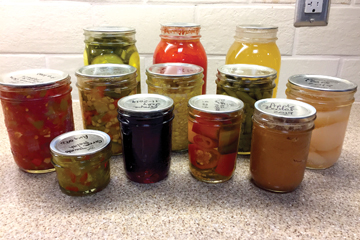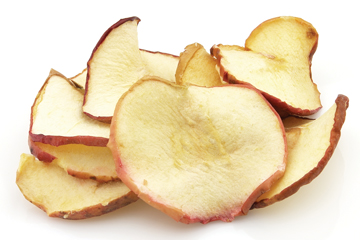
Best Practices for Storing Canned Goods

Research-tested recipes are available from Extension programs nationwide. After the effort of growing and/or preserving food, handle the jars of food according to these recommendations. These best practices can help your canned food remain high in quality and safe.
- Allow jars to stand undisturbed out of air drafts for 24 hours after canning, then check if the lids sealed.
- Food in unsealed jars can be reprocessed within 24 hours using research-tested methods.
- Remove the ring bands, being careful not to disturb the sealed lid.
- Removing the ring band allows you to see if the jars have become unsealed during storage. If you choose to reapply the ring bands, be sure the ring bands are clean and dry before applying.
- Rinse and dry sealed jars. For example, if you canned fruits in syrup, some syrup may be on the outside of the jar. This could support the growth of mold or other microorganisms.
- Wash and dry the ring bands, with hot soapy water, so they can be used in the future. Do not wash rings in the dishwasher as that will cause rust to form. Store the ring bands in a dry place.
- Label and date the jars with the contents and canning date.
- Store the jars in a cool, dark, dry place. The ideal temperature is 50° to 70° F. Do not store above 95° F. Keep jars away from hot pipes, a furnace, in direct sun or in an uninsulated attic.
- If you choose to stack jars on top of each other during storage, avoid stacking more than two jars high. To avoid disturbing the seals, place the jars in a box that held jars or place a layer of cardboard or other support material between the layers of jars.
Reference:
National Center for Home Food Preservation. (Julie Garden-Robinson, julie.garden-robinson@ndsu.edu, 701-231-7187)
Drying Apples
Canning, freezing, and pickling are standard food preservation practices, and during Fall, dehydration is a common preservation method specifically for apples. Dehydration removes moisture from food to ensure bacteria, mold, and yeast cannot grow. Successful dehydration involves low heat and humidity and proper air circulation. Dried apples are delicious in salads and excellent snacks. Learn a few tips for ensuring dried apples are delicious and safe to eat.
All apple varieties can be dehydrated; however, some hold a firmer texture than others when dried. Gala, Fuji, Honeycrisp, Granny Smith, Empire, and Cortland apples tend to hold up better when dried for fruit leather or apple chips. Pretreating apples by soaking them in ascorbic acid or an antidarkening solution for 10 minutes is recommended to prevent the apples from turning brown and changing flavor while drying.
There are different methods for dehydrating fruit, such as the microwave, oven, electric dehydrator, or sun drying. Apples can take up to 25 hours to dry in an oven, and there is a greater chance of scorching or uneven drying in the microwave. Apples are suitable for sun drying, but only if the temperature is at least 85 degrees and less than 60% humidity, which is not a typical outdoor environment in the Midwest. An electric dehydrator is an excellent option for dehydrating apples.
The temperature for safely drying apples should be between 120°F and 140°F; temperatures above 140°F may lead to the hardening of the fruit. According to the National Center for Home Food Preservation, apple rings or slices cut into ⅛ to ¼ inch pieces dry in six to ten hours in an electric dehydrator. The apples should be pliable and not stick together when adequately dried. For best quality, store dried apples in a dark and cool environment and consume them within one year.